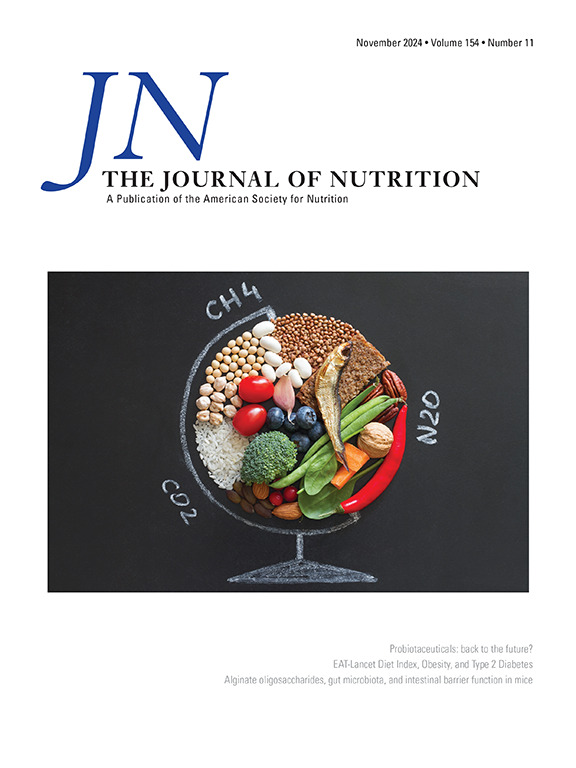南亚农村成年人吃什么,什么时候吃:来自孟加拉国、印度和尼泊尔的证据。
IF 3.8
3区 医学
Q2 NUTRITION & DIETETICS
引用次数: 0
摘要
背景:不良饮食与各种形式的营养不良和饮食相关的非传染性疾病(NCDs)有关。在南亚,关于饮食模式的数据很少。目的:我们试图描述南亚农村成年人在不同饮食场合的总体饮食质量和食物摄入量以及食物种类。方法:我们收集了来自孟加拉国(n= 2802人)、印度(n= 1672人)和尼泊尔(n= 1451人)五个地区的横断面数据。全球饮食质量评分(GDQS)应用程序用于测量前一天的食物摄入量,并将每种食物标记为进食场合。采用GDQS总分(0-49分)、GDQS阳性(0-32分)和GDQS阴性(0-17分)指标对总体、健康和不健康食物组的饮食质量、饮食不足和饮食相关非传染性疾病的风险进行评估。结果:饮食质量较低,各国在GDQS总分(17-19)、GDQS阳性(7-8)和GDQS阴性(10-12)方面得分相似。超过90%的成年人的GQDS评分水平与营养不足和饮食相关非传染性疾病的中/高风险相关,孟加拉国的高风险比例比其他国家高2-3倍。在尼泊尔,三分之一的成年人不吃早餐,在孟加拉国,男性(63%)吃零食的比例是女性(33%)的两倍。较低的GDQS总分(较差的饮食)与女性性别和较低的家庭财富有关,但与家庭作物或牲畜产量无关。结论:这些发现可能有助于为改善南亚饮食的干预措施提供信息,重点是增加健康新鲜食品的摄入,同时限制高糖、高盐和高饱和脂肪加工食品的摄入。本文章由计算机程序翻译,如有差异,请以英文原文为准。
What Adults in Rural South Asia Eat and When They Eat It: Evidence From Bangladesh, India, and Nepal
Background
Poor diets are associated with all forms of malnutrition and diet-related noncommunicable diseases (NCDs). Data on dietary patterns are scarce in South Asia.
Objectives
We sought to describe overall diet quality and intake of foods and food groups at different eating occasions among adults in rural South Asia.
Methods
We collected cross-sectional data from 5 districts across Bangladesh (n = 2802 individuals), India (n = 1672), and Nepal (n = 1451). The Global Diet Quality Score (GDQS) application was used to measure food intake on the previous day, with each food tagged to an eating occasion. Diet quality and risk of dietary inadequacy and diet-related NCDs were assessed using GDQS total (0–49 points), GDQS positive (0–32), and GDQS negative (0–17) metrics for overall, healthy, and unhealthy food group intake, respectively.
Results
Diet quality was low, with similar scores across countries for GDQS total (17–19), GDQS positive (7–8), and GDQS negative (10–12). Over 90% of adults had levels of GDQS scores associated with moderate/high risk of nutrient inadequacy and diet-related NCDs, with the proportion at high risk in Bangladesh being 2–3× higher than that in other countries. One-third of adults skipped breakfast in Nepal, and snacking was twice as common in males (63%) vs females (33%) in Bangladesh. Lower GDQS total scores (worse diets) were associated with female gender and lower household wealth but not with household production of crops or livestock.
Conclusions
These findings may help inform interventions to improve diets in South Asia, focusing on increasing intake of healthy fresh foods, while limiting intake of processed foods high in sugar, salt, and saturated fat.
求助全文
通过发布文献求助,成功后即可免费获取论文全文。
去求助
来源期刊

Journal of Nutrition
医学-营养学
CiteScore
7.60
自引率
4.80%
发文量
260
审稿时长
39 days
期刊介绍:
The Journal of Nutrition (JN/J Nutr) publishes peer-reviewed original research papers covering all aspects of experimental nutrition in humans and other animal species; special articles such as reviews and biographies of prominent nutrition scientists; and issues, opinions, and commentaries on controversial issues in nutrition. Supplements are frequently published to provide extended discussion of topics of special interest.
 求助内容:
求助内容: 应助结果提醒方式:
应助结果提醒方式:


